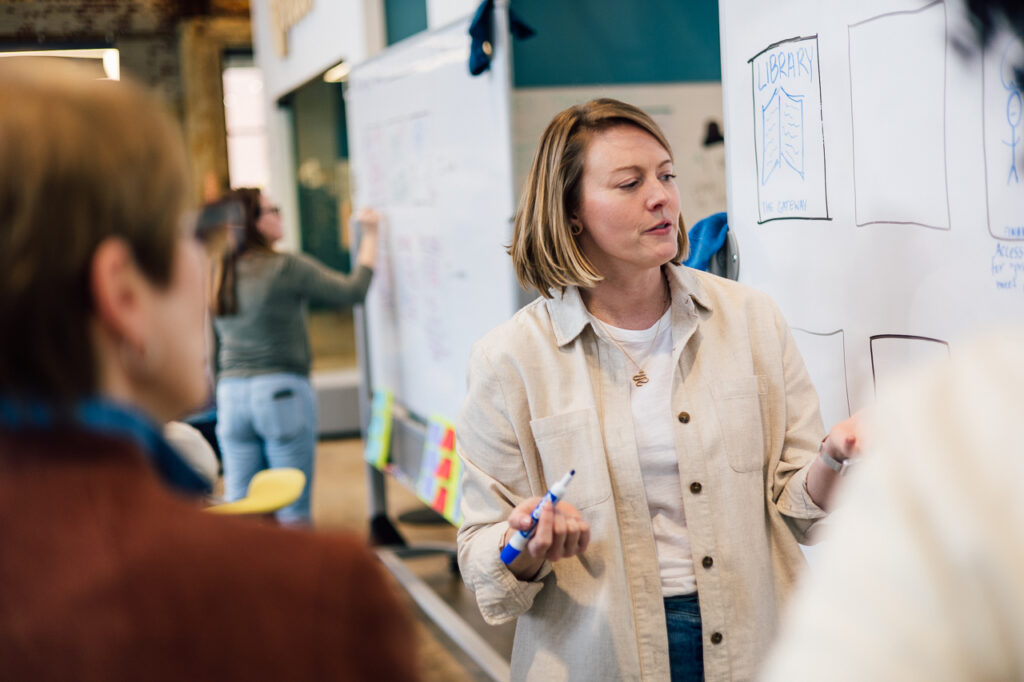Are We Solving the Right Problems? A Guide for Rising Sustainability Leaders
Perspectives on Sustainability, Quarterly Newsletter
By Ashley Wilcox, Director of Sustainability Initiatives for the School of Business

Whether you’re just starting a career in sustainability or you’re a grizzled veteran, you’re likely well versed in solutions. From carbon offsets to recycling programs and energy efficiency measures – you’re probably busy implementing and optimizing. And yes, these solutions are important. But wherever you are in your career, you need to know something crucial: The most powerful skill you can develop isn’t getting answers quickly, it’s asking the right questions.
Through my work and teaching of human-centered design, I’ve observed that the most innovative solutions emerge when we deliberately resist the urge to solve problems quickly. I’ve also seen first hand how uncomfortable it can make people when we ask them to resist the urge to jump straight to solutions – to stay in the problem space longer, to keep questioning, to dig deeper. But this discomfort is exactly where breakthrough thinking happens.
Why does this matter for your career? Right now, you might be feeling pressure to prove yourself by generating quick wins. After all, the climate crisis isn’t waiting, and your organization wants (and needs) results. But here’s what some experienced leaders have learned the hard way: Rushing to implement solutions before deeply understanding problems can lock us into approaches that look good on quarterly reports but can fall short of creating real impact.
Take a moment to consider what could happen in a sustainability project. We dive into optimizing recycling programs without questioning our relationship with waste or consumption, we focus on improving fuel efficiency without examining our fundamental transportation needs, we implement carbon offsets without challenging our core energy systems and use. Sound familiar? While these aren’t bad initiatives, they can actually become obstacles to transformation by making broken systems just efficient enough to resist real change.
Want to see what transformative thinking looks like in action? Look at Interface, a billion dollar company that revolutionized commercial flooring. As the world’s largest manufacturer of commercial carpeting, they were deeply embedded in the petroleum industry, relying on oil-based materials at nearly every step of their production process. Early in their sustainability journey, they could have simply asked, “How can we reduce our waste?” Instead, they asked something radical: “How can a factory function like a forest?” This shift in questioning led them to reimagine everything – from developing modular carpet tiles to creating closed-loop recycling systems and bio-inspired materials. The magic wasn’t in their answers; it was in asking a different question and solving a better problem.
So how can you develop this crucial skill as a sustainability leader?
First, resist the urge to jump straight to solutions, even when being pushed for quick wins. Instead, invest time in deep discovery. When faced with a challenge, try these approaches:
- Replace “How can we solve this?” with “How might we understand this differently?” This simple shift can reveal entirely new possibilities and viewpoints.
- Get out from behind your desk. Spend time talking with the people directly affected by the problem. Their experiences often reveal insights that spreadsheets and reports can’t capture.
- Map the broader system. That waste management issue? It’s connected to supply chains, consumer behavior, policy, and cultural norms. Seeing and understanding these connections can help you spot leverage points for maximum impact.
- Use prototypes to learn, not just to test solutions. Quick experiments can teach you more about the problem itself and challenge your initial assumptions (and ultimately can reduce risk along the way).
Some of you might be thinking, “In a climate crisis, we don’t have time for all this questioning.” But consider this, every time we implement a quick fix without understanding the deeper problem, we risk creating momentum in the wrong direction. The time you invest in finding the right problems to solve isn’t slowing you down. It’s multiplying your impact.
As a sustainability leader, you’ll face pressure to be the person with all the answers. Resist this. Instead, become known as someone who asks thoughtful, probing questions that lead to deeper insights. This might feel uncomfortable at first, we’re all conditioned to jump to solutions. But embracing this discomfort, the ambiguity, the not knowing, is part of growing into an effective sustainability leader.
The future belongs to those who can see beyond immediate fixes to understand the complex web of relationships defining our biggest challenges. We have the opportunity, and responsibility, to move beyond incremental improvements toward transformative change. This starts with having the courage to ask different questions and the patience to find the right problems to solve.
Remember, The difference between good and transformative solutions often lies not in how cleverly we solve problems, but in how thoughtfully we find them. Wherever you are in your journey I challenge you to make this your superpower.
